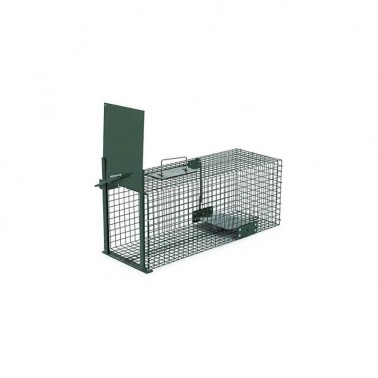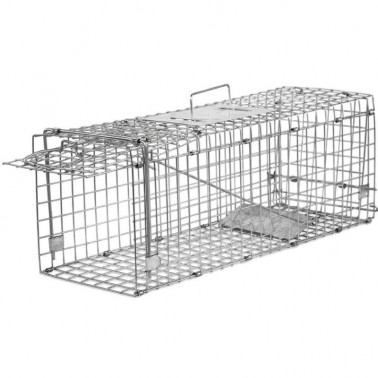Rabbit Traps
Rabbit traps are designed to capture rabbits without the need for poisons or lethal methods. These traps are especially useful in areas where rabbits can cause damage to gardens or crops.
Types of Rabbit Traps
There are several types of rabbit traps.
- Cage Traps. These cage traps are the best option, the most ethical, and recommended by BirdGard Iberia. They capture the rabbit alive without causing harm. They are cages with a door that closes when the rabbit enters to reach the bait. Choose an attractive bait for rabbits. Fresh vegetables such as carrots or lettuce are usually a good option.
- Snare Traps. These traps use a wire that closes around the animal when it passes a certain point. They tend to cause injuries to the animal.
- Adhesive Rabbit Traps. They are sticky surfaces where the rabbit gets trapped when stepping on them. This type of trap can be stressful and harmful to the animal.
Keep in mind that some types of traps may be prohibited or regulated in your area. It is always advisable to check local wildlife hunting and trapping laws.
Traps should be checked regularly to prevent captured animals from suffering for prolonged periods. Remember that the goal of a live capture trap is to catch the animal without harming it. Therefore, it is important to check the trap regularly.
Where to Place the Rabbit Cage Trap?
The location of a live capture rabbit cage trap is crucial to increase the chances of successful capture. Some tips on where to place the trap:
- Near Known Rabbit Activity Areas. For example, place the trap near the paths that rabbits commonly use to access their feeding areas.
- Near Burrows. If you can identify where the burrows are, placing the trap near them can be effective.
- Gardens and Orchards. If rabbits are invading your garden or orchard, place the trap in the areas where you see the most damage or activity. If rabbits are feeding on your lawn, place the trap on the edges where activity is most visible.
- Avoid Busy Areas. Rabbits are cautious and are more likely to avoid the trap if it is in an area of high movement or noise. Placing the trap near bushes, hedges, or under trees can make it more attractive, as it offers a sense of security.
It may take some time before the rabbit enters the trap, so be patient and consider adjusting the location if there has been no success after several days.
What Bait to Put in the Rabbit Cage Trap?
The right bait in a rabbit cage trap is crucial to ensure a successful capture. Rabbits are attracted to a variety of fresh foods, mainly vegetables. Here are some common and effective options:
- Vegetables: Rabbits are attracted to many vegetables, especially those that are part of their natural diet. Some of the most effective include: carrots, broccoli, lettuce, cabbage, spinach.
- Fresh Herbs: Herbs are another excellent option, as they are aromatic and attractive to rabbits. Some good choices are: parsley, cilantro, or dandelion.
- Fresh Forage: Wild rabbits often feed on various types of forage, so offering them hay or fresh grass can be effective.
Tips for the Bait:
- Freshness: Make sure the bait is always fresh. Rabbits have a developed sense of smell and prefer fresh foods.
- Positioning: Place the bait at the back of the trap to ensure that the rabbit enters the cage completely and activates the closing mechanism.
- Variation: If one type of bait does not work, try another. Rabbits may have preferences based on their environment and usual diet.
How to Combat a Rabbit Plague?
Combating a rabbit plague can be difficult, especially when they have established and reproduced in an area. The best tools to combat a rabbit plague are:
- Rabbit Deterrents: Motion-activated sprinkler systems or devices that work by sounds or ultrasounds. They are designed to deter rabbits without harming them.
- Physical Barriers: Fences or meshes can be effective in keeping rabbits out of specific areas.
- Eliminate Shelters: Reduce places where rabbits can hide or make their burrows, such as piles of debris, dense weeds, or thickets.
- Vegetation Control: Keeping the lawn short and eliminating weeds can make the area less attractive to rabbits.
- Live Capture Traps: Place cage traps in areas where rabbit activity has been observed.
- Predator Control. In some cases, encouraging the presence of natural predators such as foxes or birds of prey can help control the rabbit population. However, this must be done carefully to not disrupt the ecological balance.
- Pest Control Services: If the rabbit plague is large or difficult to manage, consider hiring pest control professionals.
- Rabbit-Resistant Plants: Some plants are less attractive to rabbits. Incorporating these plants into your garden can reduce the interest of rabbits. Examples include some varieties of geraniums, lilies, and aromatic plants such as lavender.
- Avoid Cruel or Illegal Methods: Some methods, such as the use of poisons, can be cruel and/or illegal. Always prioritize more ethical solutions and consult local regulations.
Combining different methods and tools can help prevent rabbits from getting used to a specific measure.
Does Vinegar Repel Rabbits?
Vinegar is a home remedy often mentioned for repelling rabbits, but the truth is that there is no solid scientific evidence to support its effectiveness. Rabbits have a very developed sense of smell, and the strong odor of vinegar can be unpleasant for them.
If you're going to try it, keep in mind that vinegar dissipates quickly, especially in conditions of rain or strong sun, so it will require frequent applications. Do not spray it on plants as it can be harmful to them. Also keep in mind that vinegar can be corrosive or damage certain materials or surfaces. As its effectiveness can vary, it is advisable to use vinegar in combination with other control measures, such as rabbit deterrents or traps.


 4 reviews
4 reviews
